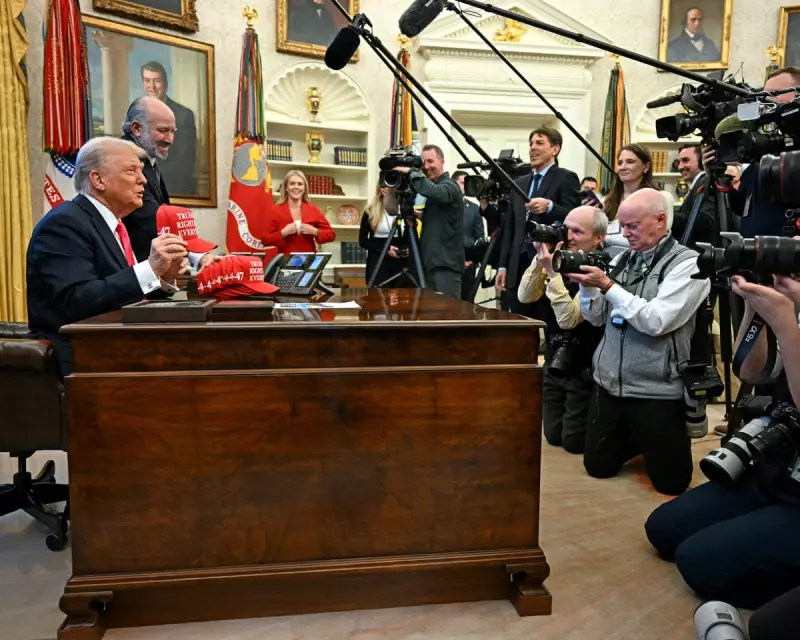
Trump's Chaotic Affordability U-Turn After Election Defeat
Following a bruising election day that saw Republicans soundly defeated, the Trump administration has launched what critics describe as a hastily assembled and poorly conceived campaign focused on affordability. The sudden pivot comes after President Donald Trump, who campaigned heavily on promises to reduce prices "starting on day one," appeared to pay little attention to the issue during his initial months in office.
The reality of voter discontent over rising costs finally struck the administration when inflation-weary Americans delivered a stark warning at the polls. Within days of the electoral setback, Trump's team initiated what observers are calling a slapdash effort to address affordability concerns.
A Campaign of Contradictions and 'Magical Thinking'
The administration's new affordability drive got off to what can only be described as a disastrous start. Just two days after election day, Trump made the astonishing claim that "Our groceries are way down. Everything is way down... So I don't want to hear about the affordability."
This statement from the billionaire president, who frequently socialises with other ultra-wealthy individuals, demonstrated what critics call utter contempt for millions of Americans who struggle with grocery bills every week. The president essentially told struggling families that their concerns were trivial compared to what he characterised as bigger priorities.
Trump's assertion that all prices were "way down" stands in direct contradiction to official data and his own policy decisions. According to Consumer Price Index figures, between January and September, prices actually rose in five of the six main grocery categories. Specific increases include meats, poultry and fish (up 4.5%), non-alcoholic beverages (up 2.8%), and fruits and vegetables (up 1.3%).
The Tariff Problem and Economic Reality Check
The president's claims become even more puzzling when considering his cherished tariff policies, which have consistently pushed prices upward. Specific examples include banana prices rising 6.9% over the past year, beef increasing by 14.7%, and coffee jumping 18.9% - partly due to significant punitive tariffs Trump placed on Brazilian coffee and beef.
Despite overwhelming evidence to the contrary, Trump continues to repeat what critics call his "big lie" about affordability. Since election day, he has repeatedly claimed there's "virtually no inflation," "prices are way down" and that "it is far less expensive under Trump than it was under sleepy Joe Biden."
The reality is quite different. Current inflation is running at a 3% annual rate, which is 50% higher than the Federal Reserve's 2% target. In another factual discrepancy, Trump boasted that gas prices had fallen to nearly $2 a gallon, while his own Department of Energy reports an average price of $3.19.
Desperate Measures and Political Damage Control
Faced with declining opinion polls and harsh economic realities, Trump advisers reportedly urged the president to abandon his "prices are down" rhetoric, which made him sound dangerously out of touch with ordinary Americans. The administration seized on one quick fix: rolling back some of Trump's beloved tariffs.
This sensible approach nevertheless contradicted Trump's long-standing assertion that new tariffs wouldn't raise prices for US consumers. With tariffs being reduced on coffee, beef, tomatoes, bananas and other tropical fruits, Trump will likely claim credit for price reductions that simply reverse his own previous policy decisions.
The president's disconnect from typical American struggles was further highlighted during his recent address to McDonald's executives and franchisees. He declared this "the golden age of America because we are doing better than we've ever done as a country" and assured listeners that "Prices are coming down and all of that stuff."
Public opinion sharply contradicts this optimistic assessment. An October Pew poll found that 74% of Americans consider economic conditions fair or poor, with only 26% rating them as good or excellent. More damningly, a CNN poll last month revealed that 61% of Americans believe Trump's policies have "worsened economic conditions in this country."
Questionable Solutions and Economic Warnings
In response to public dismay about affordability, Trump has resorted to what critics call political bribery - promising "a dividend of at least $2,000 a person (not including high income people!)." While this sounds like welcome relief for struggling families, Congress is unlikely to approve the measure given existing concerns about massive budget deficits.
The administration has also floated the idea of 50-year mortgages as an affordability solution. However, financial experts note that these would do little to reduce monthly payments - often cutting them by just $100-$200 - while more than doubling the total interest homeowners pay over the lifetime of the loan.
Economic warning signs are mounting. Trump's own Treasury Secretary, Scott Bessent, recently contradicted the president's "golden age" narrative by acknowledging that some parts of the US economy "are in recession." The manufacturing sector Trump vowed to save appears to have contracted for eight consecutive months and has lost approximately 33,000 jobs since January.
According to Mark Zandi, chief economist at Moody's Analytics, 22 states are already in recession, with their economies damaged by Trump's tariffs. Zandi fears that if major states like California and New York tumble into recession, the nation could slide into a broad economic downturn.
The tragic irony is that Trump's most effective tool for achieving his affordability goal might be pushing the country into a full-blown recession - the one outcome struggling Americans can least afford. With the administration's much-publicised affordability campaign likely to have minimal impact on prices, economic hardship may become the unintended solution to the very problem Trump promised to fix.





